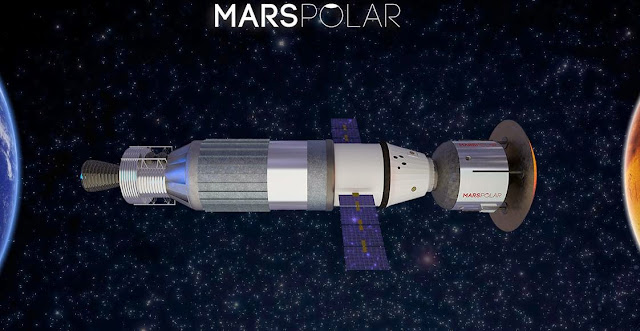 MarsPolar, a newly started international venture, is setting its sights on the Red Planet.
MarsPolar, a newly started international venture, is setting its sights on the Red Planet. The project, consisting of specialists from Russia, United Arab Emirates, Poland, U.S. and Ukraine, has come up with a bold idea to establish a human settlement on Mars’ polar region, the part of the planet with abundant quantities of water ice. The targeted area could be very interesting in terms of alien life hunting as the MarsPolar team puts it: “life begins where the water exists.”
The plan is to create the colony around 2029. “We want to send to Mars a crew of 4-6 astronauts, every 2 years,” Roman Juranek, the project’s Director of Communications for Poland, told me.
Juranek and his colleagues would like to see SpaceX’s Falcon 9 or Falcon Heavy rocket to launch the mission and also the company’s Red Dragon spacecraft to deliver cargo and crews to Mars.
“SpaceX has proved that it is worth cooperating with this company. A contract with NASA is a good proof, and we would like to establish cooperation, making use of Falcon 9 or Falcon Heavy launch vehicles.”
But before MarsPolar will be all set to send a manned mission, several spacecraft will be delivered to the Red planet with habitats and supplies for future colonists. A Mars rover is also on schedule. The rover is slated to be launched in 2018, 2 years after the start of NASA’s InSight mission on which the teams’ robot would be based on.
Who will develop the rover? This is still the open question as team wants to give a chance to every interested company and waits for the best offer.
“We want to give a chance to every company that will apply. I myself would like to see some Polish companies, because I’m aware of our [Poland’s] great designers, and students are constructing outstanding rovers, successfully competing in Mars analog contests. So there are no obstacles to build another successful one that will reach the Red Planet this time,” Juranek admitted.
Polish rovers have scooped numerous prizes in the University Rover Challenge and in the European Rover Challenge competitions.
In 2027 the Mars Transportation Vehicle (MTV) will take 35 tons of payload to the Low Earth Orbit (LEO). MTV will be load with food, water and oxygen supplies as well as more than 20 tons of hardware for future Mars explorers like: Dragon spacecraft, habitats, life support system, solar arrays, spacesuits or water extraction unit.
 |
| Artist's rendering of the Mars Transportation Vehicle. Image Credit: MarsPolar |
A month after the arrival of this first MTV's stage to LEO, the second stage with fuel tanks up to 40 tons and the additional engine will be launched to LEO and docked to the first stage. When the MTV will arrive to the orbit of Mars, the Dragon will be undocked and directed back to Earth. The rest of the MTV will aerobrake into orbit around Mars and will land with the help of a parachute.
According to the team’s website, the life support systems and the water extractor will be turned on, so the breathable atmosphere will be ready till the second ship with the crew will arrive to Mars.
Every 2 years another spacecraft could be send to the Red Planet as there is only one launch window every 26 months, when Mars and Earth line up and the journey takes only 6-7 months.
The first crew that will start its interplanetary trip to our reddish neighbor will spend a short time, from one week to one month, in Earth’s orbit, awaiting the second Falcon Heavy launch with the additional booster unit. Month after the arrival of the second MTV's stage to LEO, the stage with fuel tanks up to 40 tons and the additional engine will be launched to LEO and docked to the first stage. Then the spacecraft, using the booster unit, will be inserted toward Mars. The Landing site for the crew will be chosen near the position of the second unmanned mission.
“At this stage, it’s hard to define the exact mission schedule,” Juranek noted. “We’re dependent on the 2 year launch window to Mars.”
The astronaut selection process is also still in its infancy. The team has only specified the basic criteria not shutting the door on the vast number of future wannabe Martians. Juranek only unveiled that the candidates should have what it takes, a vocation and adequate predispositions for the job.
MarsPolar team is currently going through the organizational processes. They want to establish its base, the MarsPolar Space Center, somewhere in the UAE and their website is registered in Dubai. The team’s first goal on the long road to Mars is to create a legal private space company in the UAE.
It would be hard for the newly created project to avoid comparisons to Dutch company Mars One also planning to colonize the Red Planet with a fleet of space pioneers. But Juranek emphasizes that MarsPolar is different and it would not compete with the famed one-way mission designed by Bas Lansdorp. The new venture differs in terms of preparations for the mission and also the costs would be much lower.
However MarsPolar’s mission would also not include a return trip for the Mars colonists, at least for next ten years. Nevertheless, the team has prepared a concept of the Earth Return Vehicle (ERV), which may be used in the future.
To secure the funding for the ambitious pioneering journey to Mars and to begin the necessary activities like building the space center, MarsPolar will rely mainly on donations, investments and future business income opportunities.




Comments